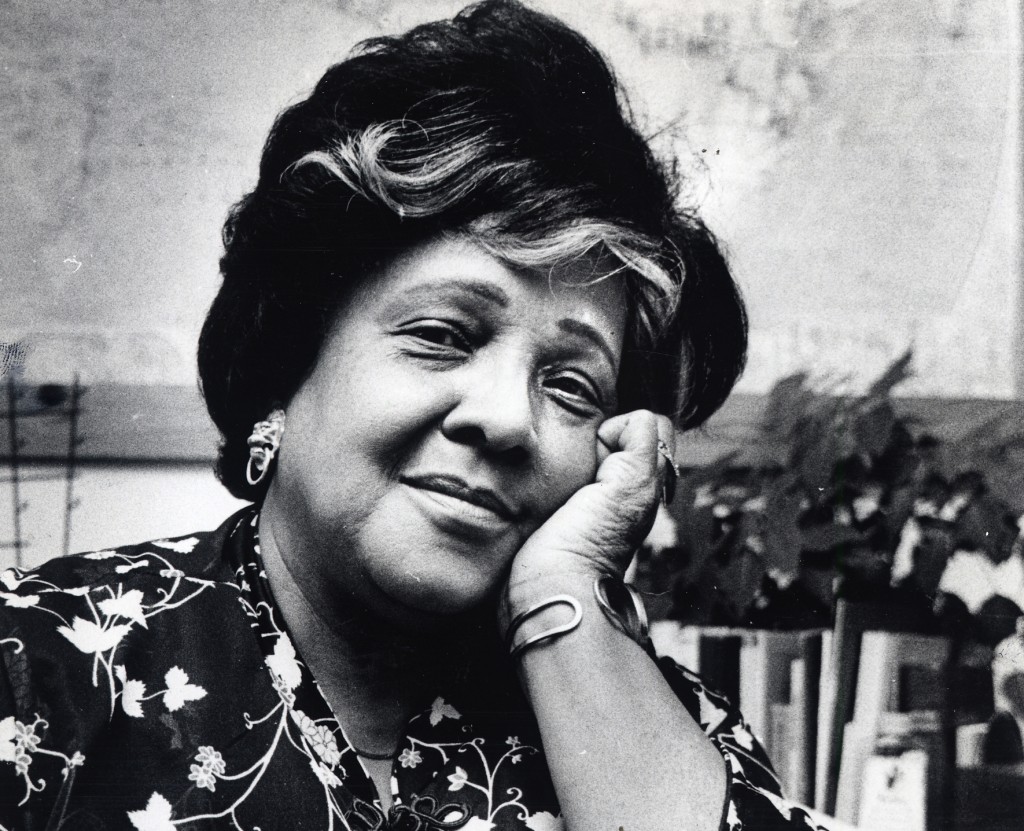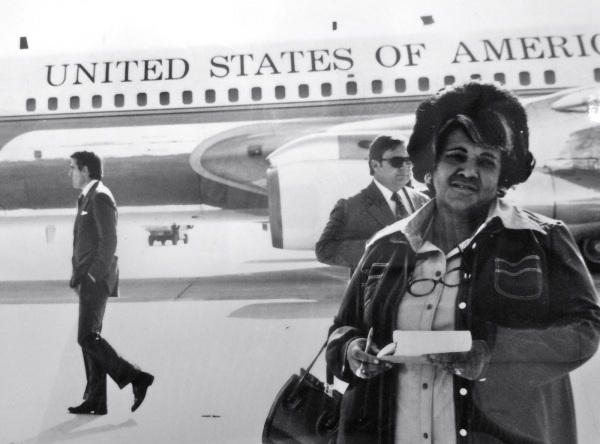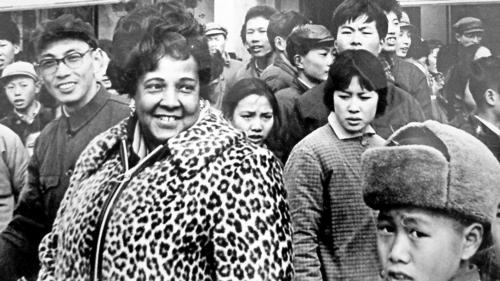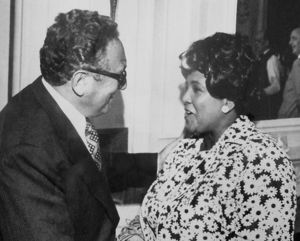
Good Morning Pou!
Today’s featured journalist is “The First Lady of the Black Press”.

Payne, Ethel Lois (14 Aug. 1911-28 May 1991), journalist and civil rights activist, was born in Chicago, Illinois, the daughter of William A. Payne and Bessie Austin. Her father worked in the city’s stockyards before obtaining steady employment as a Pullman porter, one of the best jobs then open to African Americans. He died at age forty-six, when Ethel was fourteen years old. Afterward her mother took various domestic jobs to support the family and taught Sunday school. Ethel spent her childhood in the predominantly black neighborhood of West Englewood, surrounded by white communities. She attended Chicago public schools, notably the mostly white Lindblom Technical High School. She continued her education at Crane Junior College and the Chicago Training School for City, Home, and Foreign Missions. Although she was untrained as a journalist, Payne was an accomplished and knowledgeable writer. In 1930, while only nineteen years old, she published several short stories in Abbott’s Monthly, a literary magazine, and a decade later she took evening writing courses at Northwestern University’s Medill School of Journalism.
After graduating from the Chicago Training School in 1934 with a two-year vocational degree, Ethel Payne worked as a matron in the State Training School for Girls in Geneva, Illinois, and as a nursery school teacher in settlement houses and public schools in Chicago. She completed a library training program with the Chicago Public Library and was employed as a junior librarian
From 1941 to 1943 Payne worked closely with the labor and civil rights leader A. Philip Randolph on the March on Washington Movement, which aimed to end discrimination in the military and in war industries. In 1943, in recognition of her prominence as an activist, the Illinois governor Dwight Green appointed Payne to the Illinois Interracial Commission, which was created to reduce tensions between whites and blacks and ward off race riots.
In 1948, after responding to a newspaper advertisement, Payne took a job as a hostess in a U.S. Army Special Services recreation club in Japan, where white and black soldiers remained segregated because of General Douglas MacArthur‘s disregard of President Harry Truman‘s executive order ending racial segregation in the military. During her three-year tour, she observed the interaction between black soldiers and Japanese women–romances that produced interracial babies who were shunned by Japanese society. Payne saw how Japan had been devastated by the war and the bombings. She noted that because their economy was still not strong, they welcomed the American soldiers and the money they spent. Though the soldiers were not to marry Japanese women, fraternization happened, and some of the men lived off the base with the women they loved.
When the Korean War began in 1950 Payne met two journalists working for black American newspapers who stopped in Japan on their way to report on black troops in combat. She shared with them what she had chronicled about the fraternization of black soldiers with Japanese women and gave the diary accounts she had written to L. Alex Wilson, the correspondent for the Chicago Defender, a weekly that was the flagship of the nation’s century-old black press.
The paper published a front-page article based on her diary entries with Payne’s byline under the headline “Says Japanese Girls Playing GIs for Suckers, ‘Chocolate Joe’ Used, Amused, Confused.” The article, as well as a second one, placed Payne in bad stead with the military command in Japan but garnered her a job offer from the Defender editors in Chicago.
Upon her return to her native city in 1951, Payne was first assigned by Defender editors to write features. But in 1953 the paper sent her to Washington, D.C., as its capital correspondent. Mentored by Clarence M. Mitchell, Jr., the chief lobbyist for the National Association for the Advancement of Colored People, Payne grew into an aggressive member of the White House press corps, where she was only the third African-American correspondent among the several hundred accredited reporters. Unlike the majority of journalists, Payne hammered away at President Dwight Eisenhower with questions about civil rights, a topic of importance to her black readers but ignored by representatives of the mainstream media.
Beginning in 1954 with a question about why the Howard University Choir had been excluded at the last minute from performing at a Republican event that the president had attended, Payne developed a reputation as a fearless questioner.
It was Payne’s question in July 1954, two months after the Brown vs. Board of Education decision, that received the strongest reaction, from both he president and the news media. Payne asked Eisenhower when he planned to ban segregation in interstate travel; Eisenhower barked back that he refused to support any special interest. Payne had irritated the president. Front-page stories in the Washington Post and Washington Evening Star characterized Eisnehower as being “annoyed” by the question.
After the press conference, Post political correspondent Ed Folliard, dean of the White House Press Corpos, said other reporters should have asked the question that Payne had asked. Payne believed the incident may have helped move civil rights onto the national agenda. She said “From that time on, civil rights was moved to the front burner. Suddenly civil rights began to be the big issue.”
After the incident, Eisenhower boycotted Payne by not recognizing her during press conferences. The exchange landed Payne on the front pages of newspapers and made her a sensation. It also brought down the wrath of the White House press office, which threatened to take away her credentials. Payne speculated that the President’s displeasure caused White House Press Secretary James Hagerty to call her into his office and accuse her of violating the rules of the White House Correspondents Association. He also investigated her tax returns. The incident became public when syndicated columnist Drew Pearson reported on the threats in The Washington Post and other newspapers.
Further potential conflicts were eased by Payne’s growing absence from Washington as she expanded her reporting to overseas and to civil rights in the South.
In 1955 the Defender sent Payne to Indonesia to cover the Bandung Conference (Asian-African Conference), a meeting of twenty-nine leaders from third world countries, many of which were newly independent nations, representing 1.5 billion people of color. The exclusion of leading world governments from the conference was a source of consternation to U.S. leaders. But among African Americans the conference was widely supported, and the U.S. congressman Adam Clayton Powell, Jr., and the writer Richard Wright were among those who attended the gathering.
Following the conference, Payne completed a circumnavigation of the globe, reporting from nine nations. Back home Payne extensively covered rapidly developing desegregation events in the South from the 1955 Montgomery bus boycott to the 1957 Little Rock crisis. Her reports from the South and her public role in the Washington press corps made her one of the most visible chroniclers of the civil rights movement for African Americans. Over the subsequent decades she would become known as the “first lady of the black press.”
In 1957 Payne accompanied then vice president Richard Nixon to Ghana, which was celebrating its colonial independence. There she witnessed the first meeting between the civil rights leader Martin Luther King, Jr., and Nixon. Payne perceived the central role that a twenty-seven year old minister from Atlanta was to play in the revolution. The coverage included an exclusive interview and a full page picture of the Reverend Martin Luther King Jr.
Payne traveled throughout the South, staying in private homes because hotels refused to register African Americans. She wrote a series titled “The South at a Crossroads”. The series, which the Defender promoted with a front page photograph of Payne, provided in-depth analysis of the American South at this crucial moment in its history.
To report on the Little Rock desegregation story, Payne stayed in the apartment of a white college professor – until rocks came hurling through her bedroom window and the professor was evicted. Recalling the crowd that surrounded her and other marchers as they left Selma, Payne said “You could just feel the hatred. It was just like an enveloping cloak around you. I’ll never forget the faces, the contorted faced of housewives, standing out and screaming like they were just lunatics from the asylum: Nigger! Nigger! Nigger!”
President Lyndon B. Johnson recognized that Payne was more than a mere chronicler of events. When he signed the Civil Rights Act of 1964 and the Voting Rights Act of 1965, he asked leaders of the modern civil rights movement to join him in the Oval Office. Among those leaders was one woman, Ethel Payne.
Payne left the Defender for better-paid positions in organized labor and the Democratic Party in 1958, but returned to the paper in 1967 to become the first African-American correspondent to report from Vietnam. Upon completing a three-month tour, Payne resumed her Washington beat but continued to travel widely. In 1969, for instance, she covered the civil war in Nigeria. Payne moved back to Chicago in 1973 to assume a post as an editor at the newspaper. Meanwhile CBS News also hired Payne as the first African-American female commentator in national broadcasting. She worked on the television and radio series Spectrum.
During this time Payne expanded her international reporting. She was among the earliest American journalists to tour China, following President Nixon’s historic visit in 1972, and she covered multination tours of African countries by the secretaries of state William P. Rogers and Henry Kissinger, as well as making numerous other reporting trips to the continent.
In 1978 she resigned permanently from the Defender and ended her relationship with CBS, eventually resettling in Washington, D.C., and self-syndicating a column. In the 1980s Payne became supportive of the antiapartheid movement and was arrested protesting at the South African embassy in Washington, D.C. In 1990 she traveled to South Africa to meet with Nelson Mandela shortly after his release from prison.
Payne died of a heart attack alone in her Washington apartment at age seventy-nine. She remained single to the end of her life, saying, “I was married to my work.” She was buried in Chicago. The National Association of Black Journalists dedicated a fellowship in her honor to assist reporters wanting to travel to Africa. In 2002 the U.S. Postal Service issued a commemorative stamp with her likeness.
Ethel Lois Payne pursued a career in journalism as an African-American woman during the civil rights movement and prior to gains in gender equality; she was a trailblazer and an inspiration to a generation of black women aspiring to careers in the media. Equally important, Payne advanced the cause of civil rights by using her reporting to both enlighten and activate black readers across the country and to bring issues of importance to the black community to the attention of Washington decision makers.




